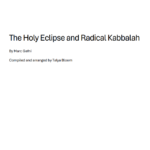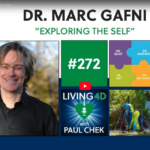House of Mirrors – Marc Gafni
by Marc Gafni
When the book Soul Prints was published, the bulk of the writing and thinking at the time remained excluded from the final edition. I had submitted an eight hundred page manuscript to Simon & Schuster; my editor, Emily, was less than thrilled with this; the second half of the manuscript was about Shadow, the darker and more unconscious side of human reality.
Those pages will, in the near future, be made available in this section of the website.
Since that time, my thinking on shadow has unfolded and evolved significantly. I have had opportunity to teach the Shadow material in my teaching circles in Israel and the United States as well as in public dialogues with Ken Wilber, and in conversations with Diane Hamilton, Terry Patten and others. In the last year and half, my thinking and feeling on all this has evolved again.
One of the core constants in my understanding of all this is the intimate relationship between the thwarting of Unique Self and Shadow. While in my later writing this evolves into a non-dual understanding of Shadow – the following excerpt from my early writing remains a valuable insight into Unique Self and Shadow as they play in our lives.
In order to identify our unique selves {in theistic terms – soul prints} and to respond to the voices that call us to meaning we need to first experience the world as meaningful. One of the great cries of modernity is that it all seems to be a house of Mirrors. The image of the house of mirrors indicates our feeling that there is no core essence in the world; rather all is a grand joke, an illusion, a house of mirrors in a cruel carnival. Life too often seems absurd. Nothing really matters. ‘Absurdus’ means ‘fully deaf’ in Latin. So often we moderns, strain mightily and often vainly, to hear the call or sense the innate purpose of being.
I believe that any thoughtful person has house of mirror moments, maybe even house of mirror years. In the end however life is a decision for meaning. There are only two choices in life. Either everything is meaningful or nothing is meaningful. If choosing to be Mother Teresa instead of Hitler is meaningful then everything is meaningful. If remembering my son’s birthday matters then everything matters.
However suggest mystic Abraham Kuk in an image powerfully germane to our discussion about the path of darkness and broken vessels – the world is indeed all mirrors. Kuk, in his own commentary on the “Great cosmic catastrophe,” the mystical creation myth of the breaking of the vessels, implies that the original vessels which shattered were actually mirrors.
The following is my free flowing rendition of Kuk’s core idea.
In the beginning there was a darkness
and in the darkness hung a mirror.
And into the mirror gazed a light.
– A single flame reflected in a vast looking glass
And as this flame gazed at her reflection
She saw the light that it was good.
And she desired more of herself to be seen.
And so she beamed brighter into the mirror.
And brighter, and brighter
until the intensity of her light
Shattered the looking glass –
And sent shards by the billions into every direction.
And the flame gazed into each and every shard
And saw her face multiplied by the billions.
And she saw the shattering that it was also good.
For the broken mirrors magnified the light.
In the beginning there was a darkness…
And in the end, a billion points of light.
Originally there was one great mirror of existence reflecting the light of a single infinite flame. The flame however desired that its light be reflected more widely. So it shattered the mirror into a thousand fragments. Shards of mirrors strewn across the world. True, you have to be careful where you walk…for these shards are sharp; the brokenness can bite. But if held carefully and held right, these very shards can be put to great use. What can you do with a shard of mirror? Simple, you can catch the light…multiply its brilliance, and reflect it into the darkest of corners.
What’s more, the Kabbalists go on to say that these shattered shards are our stories themselves. Our personal stories are the fragments of a larger story our mirrors are slivers of a larger mirror. Each fragment has a unique ability to shine light into a particular dark place. The first place that we need to shed light is in the shadow crevices of our own souls, hidden from the light by the twists and curves of each of our stories. Once we do that, then we are able, through living our story, to reflect light into the outer crevices and crannies which we encounter on our path.
It all Depends of Love
In order to have the courage to shine light into our darkness we must extend our exploration further still into the forest of our psyche. There was, at the Great Gathering, a second path that the mystics paced. This was the path of love. B’Chavivuta Talya Milta. “It all depends on love,” said Shimon Bar Yochai to the small group of friends who had gathered with him in the field. Love is to perceive the unique self, the soul print in the footsteps of the dragon. Self love – in the nomenclature of this mystical text – is the ability to embrace and ultimately transform, my shadow. Love as understood by the Alter Rebbe, which I have explained in greater depth in my book Soul Prints, is not an emotion. It is rather a perception-identification* complex which gives birth to an emotion. Love is to perceive the infinite and unique specialness in other or self and to identify them or myself with that specialness. Love is a perceptive art. It is only from the security of this self-perception that one is able to acknowledge shadow.
Abraham Kuk, writing in Jerusalem between the world wars, taught that the purpose of living is to learn what he calls “the great art of loving.”
Ultimately what the mystics are teaching is that the path of the dragon can only be walked in love. Indeed the two paths that of embracing Tzel, the path of the dragon and the path of love are really one path.
There is a wonderful Bhuddist story about a man with a Garden overrun with Dandelions. At his wits end he goes to consult the elderly gardener who lives down the street. A wise old woman with a rose garden you wouldn’t believe. She slowly walks with him to see his garden, listening to his lament over the dandelions along the way. By the time they arrive at his gate, she has one look at the yard and says decisively, “I’ll tell you exactly what you need to do…” Sasha nods eagerly, poising his pen on pad to capture the precious advice. The old woman puts her hand over the notepad, looks straight into Sasha’s eyes and says, “You need to learn to love dandelions.”
In Kabbalistic sources the Gardner is often a symbol for the Shechina the divine feminine incarnate in the human psyche. It is through the nurturing advice of the Gardner that we human beings can tend our garden. Suggests the wisdom tale: We all have Dandelions. If we but love them they may well become roses before our very eyes. The way of the darkness must be tread with love.
Into the Light
Most of the images we have suggested thus far are somehow related to light. Indeed the core image of soul in virtually every literature of the spirit is light. We are searching for soul print light. So where do we find light in biblical myth wisdom?
The primary source of light in Biblical mysticism is the temple in Jerusalem. In the temple burns the source of all light.
What is the nature of this light? Well, we know two things about the temple which is of overwhelming relevance to our discussion. First the entire temple was actually one great work of art. Second, that the physical structure of the temple and its vessels were fashioned by an artist named Bezalel. Now, the name Bezal-el is usually translated as, “In the shadow of God.” Biblical mystics, however, read his name differently, suggesting that Bezalel means, “In the Shadow is God.”
The artist with his stained hands knows how to touch the dark places. He is a student of Bezalel, versed in the ways of darkness. I look at my own white palms and think of all the times I have avoided the depths. How my hands sometimes flee from the darkness, avoiding being dirty for too long. I remember that the brilliant flower with her delicate painted petals grew out of the dark soil, nourished by worms, debris, and decay. I remind myself that diamonds are black coal made beautiful by intensity and pressure.
The artist creates from her own shadow and, teach the kabbalists, we are all artists of our own lives, engaged in the ultimate sacred act of self-creation. Nietzsche correctly intuited a core biblical idea when he said, “the artist becomes the work of art.” Life is self creation – the painting of our destiny on the canvas of our fate.
In biblical myth language the word for ‘creation’ is Yatzar. But this word also has a second meaning Yatzar, also represents primal, even dark, passions. We reveal our light, our soul print – from the shadows. The shattered vessels of our miniature temple, which for Luria was the image of our souls, can only be made whole again if we are willing to enter the ruins of our lives and dreams, and from there reveal our unique self, our soul print.
Available by Marc Gafni








